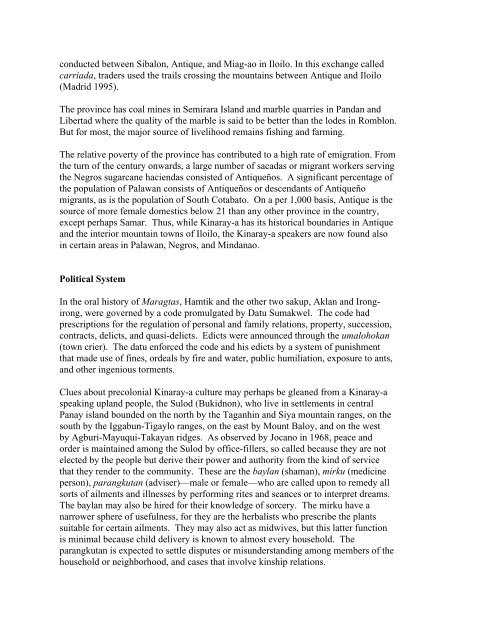Kinaray-a
Kinaray-a
Kinaray-a
Create successful ePaper yourself
Turn your PDF publications into a flip-book with our unique Google optimized e-Paper software.
conducted between Sibalon, Antique, and Miag-ao in Iloilo. In this exchange called<br />
carriada, traders used the trails crossing the mountains between Antique and Iloilo<br />
(Madrid 1995).<br />
The province has coal mines in Semirara Island and marble quarries in Pandan and<br />
Libertad where the quality of the marble is said to be better than the lodes in Romblon.<br />
But for most, the major source of livelihood remains fishing and farming.<br />
The relative poverty of the province has contributed to a high rate of emigration. From<br />
the turn of the century onwards, a large number of sacadas or migrant workers serving<br />
the Negros sugarcane haciendas consisted of Antiqueños. A significant percentage of<br />
the population of Palawan consists of Antiqueños or descendants of Antiqueño<br />
migrants, as is the population of South Cotabato. On a per 1,000 basis, Antique is the<br />
source of more female domestics below 21 than any other province in the country,<br />
except perhaps Samar. Thus, while <strong>Kinaray</strong>-a has its historical boundaries in Antique<br />
and the interior mountain towns of Iloilo, the <strong>Kinaray</strong>-a speakers are now found also<br />
in certain areas in Palawan, Negros, and Mindanao.<br />
Political System<br />
In the oral history of Maragtas, Hamtik and the other two sakup, Aklan and Irongirong,<br />
were governed by a code promulgated by Datu Sumakwel. The code had<br />
prescriptions for the regulation of personal and family relations, property, succession,<br />
contracts, delicts, and quasi-delicts. Edicts were announced through the umalohokan<br />
(town crier). The datu enforced the code and his edicts by a system of punishment<br />
that made use of fines, ordeals by fire and water, public humiliation, exposure to ants,<br />
and other ingenious torments.<br />
Clues about precolonial <strong>Kinaray</strong>-a culture may perhaps be gleaned from a <strong>Kinaray</strong>-a<br />
speaking upland people, the Sulod (Bukidnon), who live in settlements in central<br />
Panay island bounded on the north by the Taganhin and Siya mountain ranges, on the<br />
south by the Iggabun-Tigaylo ranges, on the east by Mount Baloy, and on the west<br />
by Agburi-Mayuqui-Takayan ridges. As observed by Jocano in 1968, peace and<br />
order is maintained among the Sulod by office-fillers, so called because they are not<br />
elected by the people but derive their power and authority from the kind of service<br />
that they render to the community. These are the baylan (shaman), mirku (medicine<br />
person), parangkutan (adviser)—male or female—who are called upon to remedy all<br />
sorts of ailments and illnesses by performing rites and seances or to interpret dreams.<br />
The baylan may also be hired for their knowledge of sorcery. The mirku have a<br />
narrower sphere of usefulness, for they are the herbalists who prescribe the plants<br />
suitable for certain ailments. They may also act as midwives, but this latter function<br />
is minimal because child delivery is known to almost every household. The<br />
parangkutan is expected to settle disputes or misunderstanding among members of the<br />
household or neighborhood, and cases that involve kinship relations.
















